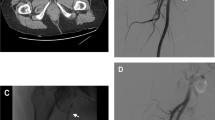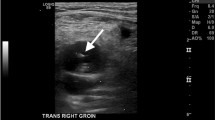Summary
Background Complicating femoral artery puncture aneurysms may occur resulting in the need for surgical or newer, non- or minimal-invasive therapy: A new minimal-invasive method is the percutaneous occlusion injecting bovine thrombin. The high thrombogenous potential of thrombin bears the risk of iatrogenic artery occlusion by artificial intravascular instillation. Aim Is the contrast-ultrasound guided thrombin injection safe and effective in occluding femoral aneurysms? Methods During 1/99 to 12/00, 33 femoral artery aneurysms as a complication coronary catheterization were diagnosed. In 32 patients the aneurysm (mean dimensions 32×35×24mm) was punctured during ultrasound guidance. By injecting ultrasound contrast medium, the flow pattern perfusing the aneurysm was documented. In the canula position where no contrast medium exited the aneurysm thrombin was injected. Results Complete occlusion of the aneurysm was achieved in 96.9% (31 out of 32) of the patients by contrast-ultrasound guided thrombin occlusion. Follow-up for up to 3 months after the procedure revealed complete occlusion and no clinical or sonographical complications. In one case, a large aneurysm (50mm×62mm×27mm) had already led to skin alterations and was only partly occluded by thrombin injection. Conclusions Contrast-ultrasound guided thrombin occlusion of femoral artery aneurysms is safe and highly effective.
Zusammenfassung
Hintergrund Ein Pseudoaneurysma oder perfundiertes Hämatom (PH) tritt vor allem komplikativ im Rahmen von Katheteruntersuchungen mit transfemoralem Zugang auf. Alternativ zum operativen Verschluss wurden in den letzten Jahren nicht- oder minimal-invasive Verfahren zur Therapie des PH entwickelt. Ein noch selten eingesetztes minimal-invasives Verfahren ist der Thrombinverschluss mittels bovinem Thrombins. Die hohe thrombogene Potenz des Thrombins birgt aber die Gefahr einer iatrogenen Thrombosierung der großen Extremitätengefäße durch eine artifizielle Injektion dieser Substanz. Fragestellung Kann mit der kontrast-ultraschallgesteuerten Thrombin-Injektion ein PH sicher und erfolgreich behandelt werden? Material und Methoden Von 1/99 bis 12/00 konnten farbduplexsonographisch 33 perfundierte Hämatome diagnostiziert werden. 32 Patienten entschieden sich für einen Thrombinverschluss. Die Größe der PH betrug im Mittel 32×35×24mm. Es erfolgte eine ultraschallkontrollierte Punktion des PH. Durch die Injektion von Ultraschallkontrastmittel konnten die Flussverhältnisse in PH exakt bestimmt werden. In der Nadelposition, in welcher kein Ultraschallkontrastmittel in die Arterie abgeschwemmt wurde, erfolgte die Thrombin-Injektion. Ergebnisse Bei 96,9% (31 von 32) Patienten konnte ein Komplettverschluss durch die kontrast-ultraschallgesteuerte Thrombin-Injektion erreicht werden. Klinische und farb-duplex-sonographische Kontrollen bis zu drei Monate nach Thrombinverschluss ergaben in allen Fällen einen unkomplizierten und anhaltenden Verschluss. Bei einem Patienten mit einem 50×62×27mm großen Aneurysma und bereits manifesten Hautläsionen konnte nur ein Teilverschluss erreicht werden. Schlussfolgerung Die kontrast-ultraschallgesteuerte Thrombin-Injektion ist eine wirksame und sichere Therapieoption zur Behandlung eines iatrogen entstandenen perfundierten Hämatoms.
Similar content being viewed by others
Author information
Authors and Affiliations
Additional information
Eingegangen: 12. Februar 2001 Akzeptiert: 12. April 2001
Rights and permissions
About this article
Cite this article
Grewe, P., Deneke, T., Fadgyas, T. et al. Die perkutane Kontrast-ultraschallgesteuerte Thrombin-Injektion zur minimal-invasiven Therapie des iatrogen entstandenen Pseudoaneurysma. Z Kardiol 90, 737–744 (2001). https://doi.org/10.1007/s003920170093
Issue Date:
DOI: https://doi.org/10.1007/s003920170093




